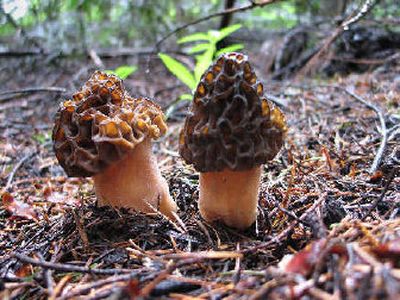Hotbed of mushroom hunting

Aside from a firefighter, nobody pays closer attention to forest fire reports than a mushroomer.
A summer fire in this region usually results in a bounty of prized morel mushrooms the following spring.
Lynda Foreman, president of the Spokane Mushroom Club was among a group that eagerly traveled last month to southeastern Washington where a forest fire scorched 52,000 acres in the Tucannon River region last summer.
“Unfortunately, I think we were a little early,” she said. “In two days we came up with 250 morels. With the cost of travel and everything, I figured that out to $1.66 apiece.”
She had a much better season the spring after the 1991 firestorm in forested areas near Colbert. “We’d go out and pick three to five gallons of morels day after day,” she said.
“The second year after a fire you’ll find about half as many.
“The third year you’ll find only 25 to 30 percent of what you found the first year.”
Foreman has been leading mushroom forays for 23 years. “I can spot a morel off the road at 60 mph,” she said while driving north of Spokane with a group of eager mushroomers last weekend.
Her goal is to educate club members about wild mushrooms, so they harvest in a way that won’t deplete them while emphasizing identification and safety in an activity that can be as toxic as it is delicious.
“Even experienced mushroomers are known to get careless and poison themselves or the people they feed,” she said. “It’s fun to learn about mushrooms to appreciate their beauty the way we appreciate wildflowers. But if you plan to eat mushrooms, you need to be educated.”
As much as she knows about fungi, Foreman does not consider herself an expert.
“We send mushrooms off to the real experts when we’re in doubt about identification,” she said.
Imposters often are misidentified even for the common and avidly-hunted morel, she said, showing her group diagrams of two mushrooms that can look like morels. One of them is poisonous.
While forest burns are obvious hot spots for spring mushrooming, morels also are found in green forest landscapes. “Grand fir, ponderosa pine, aspen, birch and willows are indicators that morels might be around,” she said. “But if you get into cottonwoods and find something that looks like morels, they’re probably not the kind you should eat.”
Even expert mycologists are still learning significant lessons about mushroom gathering.
Years ago, mushroomers began harvesting their bounty into mesh bags so spores from the mushrooms would sprinkle around the forest as they walked.
More recently, researchers have found that it’s best to use a knife to cut the stems at ground level rather than plucking mushrooms from the earth and damaging the stem systems that are important to the future production of mushrooms, Foreman said.
Morels flourish in the right spring combination of dampness and warmth. “I start looking for them when the ground temperature is 40 degrees two inches below the surface,” Foreman said. “That’s about the time the strawberry plants are in blossom and the fiddlehead ferns are up and beginning to unfurl.”
Last weekend, the Spokane mushroomers found only a few morels at an elevation of 3,600 feet. “Maybe we’re early here,” Foreman said. “They drove downhill on logging roads to lose a few hundred feet of elevation and found a much better supply of blonde and black morels, plus coral mushrooms.
As the morel season fades in this region, the Spokane mushroomers are planning trips to burned areas in Montana that should be coming on strong in the next two weeks. They’ll dry their bounty and enjoy other pursuits through the summer before coming out strong again in September.
“Fall mushrooming is even more fascinating,” Foreman said. “Spring mushrooms tend to be the color of white, brown or rust. The fall species have a lot more color – reds, oranges, purples, lavender – and there are a lot more varieties.”
The annual last-weekend-in-September foray at Priest Lake can turn up 300 varieties of mushrooms, she said, adding that “A spring foray in the same area would turn up about half that many species.”
Of course, fungi also are found all around us, even right here in town.
Foreman has numerous reliable mushrooming spots, including parks, where she brings field classes of students she teaches in spring and fall through the Institute for Extended Learning branch of the Spokane Community Colleges.
“Morels often pop out of landscaping bark, and fairy ring mushrooms in lawns are quite delicious,” she said. But even the edible mushrooms can be tainted when found in parks or yards.
“The mushrooms will pick up the pesticides and herbicides,” she said. “I wouldn’t eat them.”